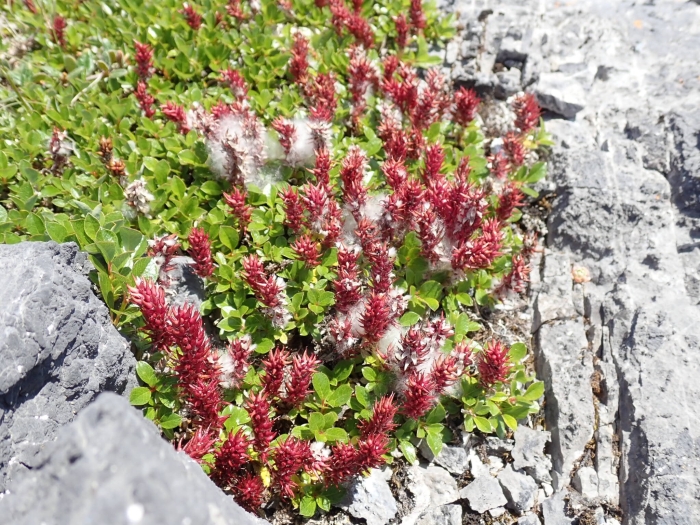Bearberry Willow
(Salix uva-ursi)
Bearberry Willow (Salix uva-ursi)
/
/

John Brew
CC BY 4.0
Image By:
John Brew
Recorded By:
Copyright:
CC BY 4.0
Copyright Notice:
Photo by: John Brew | License Type: CC BY 4.0 | License URL: http://creativecommons.org/licenses/by/4.0/ | Rights Holder: John Brew | Publisher: iNaturalist | Date Created: 2018-07-14T10:33:05Z |

























Estimated Native Range
Summary
Salix uva-ursi, commonly known as Bearberry Willow, is a deciduous, prostrate shrub native to the tundra and rocky alpine environments of northeastern North America, including the high mountains of northern New England, and extending to Greenland. It typically forms low, dense mats no more than 6 inches (15 cm) high, spreading to several feet wide. Bearberry Willow has adapted to survive in harsh, cold, and moist conditions, often found near streams, in wet meadows, and on moist, rocky slopes.
The Bearberry Willow is characterized by its small, leathery leaves and flexible stems that root at the nodes. It produces inconspicuous yellow or green flowers in the spring, followed by small capsules containing seeds. This willow is valued for its ability to stabilize soil and for its resilience in extreme environments. It is used in restoration projects, especially in alpine and subalpine regions, and can be an attractive ground cover in rock gardens. In cultivation, it requires consistently moist soil and can tolerate partial shade to full sun. While it is not commonly affected by diseases, it can suffer from root rot if the soil is not well-drained.CC BY-SA 4.0
The Bearberry Willow is characterized by its small, leathery leaves and flexible stems that root at the nodes. It produces inconspicuous yellow or green flowers in the spring, followed by small capsules containing seeds. This willow is valued for its ability to stabilize soil and for its resilience in extreme environments. It is used in restoration projects, especially in alpine and subalpine regions, and can be an attractive ground cover in rock gardens. In cultivation, it requires consistently moist soil and can tolerate partial shade to full sun. While it is not commonly affected by diseases, it can suffer from root rot if the soil is not well-drained.CC BY-SA 4.0
Plant Description
- Plant Type: Shrub
- Height: 1-2 feet
- Width: 1-2 feet
- Growth Rate: Moderate
- Flower Color: N/A
- Flowering Season: Summer
- Leaf Retention: Deciduous
Growth Requirements
- Sun: Full Sun
- Water: Medium, High
- Drainage: Medium, Fast
Common Uses
Bank Stabilization, Border Plant, Low Maintenance, Water Garden
Natural Habitat
Tundra and rocky alpine environments, often near streams, in wet meadows, and on moist, rocky slopes
Other Names
Common Names: Small Net Willow, Netleaf Willow
Scientific Names: , Salix uva-ursi, ? labradorica, Salix arbuscula var. labradorica, Salix cutleri, Salix cutleri f. major, Salix cutleri f. minor, Salix cutleri var. labradorica, Salix ivigtutiana, Salix myrsinites f. parvifolia
GBIF Accepted Name: